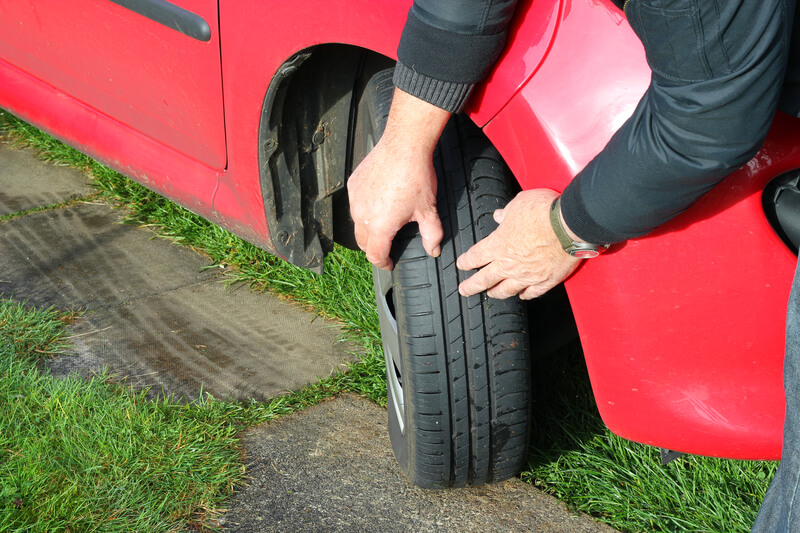Carmakers are finally bringing back vehicle buying incentives (though barely), which means we may be turning a corner on the sky-high new car costs customers have seen since the pandemic began. Still, many buyers will turn to used cars until prices drop more significantly, and shopping used requires research on reliability, IIHS safety rankings, insurance costs and modern safety features.
While it’s easy to assume a new car will come with the latest safety features, especially if it’s a luxury model, there’s a lot of variation in older vehicles—even if they’re late models. Electronic stability control should be at the top of your list, especially if you’re buying an SUV, truck or van. Thankfully, it’s been standard since 2012. Other features like automatic emergency braking, blind spot warning and forward collision warning are widely available and can help avoid accidents. Ongoing research into self-driving cars makes it a given that new technologies will pop up each year, while older features become standard, and, eventually, government mandated.
Comparison shopping can be hard, especially since automakers tend to choose unique names for their proprietary tech. But there are tools to help. The National Highway Traffic Safety Administration (NHTSA) makes models searchable—simply pop in the make, model, year and trim style of your spotlighted vehicle and come away with a list of safety features included. Consumer Reports regularly updates its list of best used SUVs, sedans and small cars, created with an eye toward safety features. The Insurance Institute for Highway Safety (IIHS) lets you search crashworthiness but also crash avoidance and mitigation.
So, as you start your search, what are the car safety features you should know, and how did some now standard features start out?
What is the best safety feature in a car?
While we tend to think of electronic sensors, lasers and cameras when it comes to safety features, the most basic is one we (hopefully) use without thinking: the seat belt.
Seat belts made it to the Indy 500 as far back as 1922, but they weren’t widely adopted in passenger cars for decades. Why? Many drivers believed it was better to be flung clear of the wreck, and automakers thought seat belts would create a negative image. Volvo engineered a three-point system in 1959, allowing other automakers free use of their design. By 1968, federal law required front lap and shoulder belts.
It wasn’t until the ‘80s and ‘90s though that drivers and passengers started buckling up in higher numbers. Today, national use is at 91.6 percent, according to the NHTSA. The organization also lists it as the “single most effective thing you can do to protect yourself in a crash.”
Unless you’re driving a Betty Draper-vintage station wagon, the good news about this safety feature is that almost all vehicles will have belts. You just have to use them, every time and no matter how short the drive.
Other near-universal features (present in all except very old or vintage vehicles) include:
- Airbags: Standard since 1999, airbags are meant to be used in conjunction with seatbelts. Newer vehicles have side-curtain airbags and detection technologies that determine the size and position of front-seat occupants. To avoid airbag injuries, kids should stay in the back seat through age 12, and rear-facing child restraint systems should never be used in a front seat. A few years back, tens of millions of Takata airbags were recalled due to explosions during deployment. Many of those recalled vehicles are still on the road, but it’s easy to see if your vehicle is affected by an airbag recall or any other recall with a VIN search.
- Antilock brakes: Drivers’ education curriculum changed with the widespread adoption of antilock brakes, mandatory since 2000. The technology pumps the brakes for you in a hard stop, allowing you to maintain steering control.
- LATCH: Child-safety seats used to require sometimes-complex seatbelt attachment systems making them challenging to install correctly or move between vehicles. Mandatory since 2002, LATCH creates a universal system of lower anchors and top tethers to work with any infant seat, convertible seat or booster.
Safety features you’ll want to look for in used cars
If you’re in the market for an older used car, it’s important to note what safety features are most important to you and choose models with reliable systems. Here are a few you’ll want to include on your used car “must haves”:
Electronic stability control, or ESC, helps avoid spinouts and rollovers by keeping tires on the road. ESC has been mandatory since 2012, though many vehicles, especially luxury models, had it before then. If you’re buying your first vehicle, or if you’re shopping for a starter car for your teen, stay in that date range, or choose a car that featured this potentially life-saving technology before it was required.
ESC uses sensors to detect when a car’s direction and driver’s steering don’t match up. It also kicks in when a driver overcorrects during an emergency, like a too-fast turn or a hydroplane. If the system engages, it automatically adjusts each wheel’s brakes. ESC systems also help reduce the likelihood of a rollover. Note that if your tires aren’t in good conditions, ESC won’t work like it’s supposed to.
Traction control, or TC, has also been mandatory since 2012, making it an important feature if you’re looking for an older vehicle. TC slows the speed of a wheel that’s losing its grip on the road. When one tire starts to spin faster than the car’s speed, the sensors assume the vehicle is hydroplaning or skidding and the system kicks in to correct.
Backup cameras have been mandatory since 2018, though many earlier models feature them as well. The technology isn’t too complicated: a camera mounted on the rear of the car feeds into a console screen and alerts the driver if there’s a pedestrian or other object in their expected path.
Newer cars might include parking guidance systems, meant to help a driver navigate into a tight spot or parallel park. Intelligent parking assist systems even have self-driving features that guide the car into a spot.
What are some newer safety features in a car?
If you’re buying a new or late-model used vehicle, you’ll find a whole host of features that may not have been present in your last car. As automakers work to develop self-driving technologies, the innovations are changing what’s considered standard.
While some systems warn you of risks, others actually intervene to avoid a crash. If the technology is new to you, take some time to understand the systems and read about them in the owner’s manual. Here are some of the top features you’ll expect to see in newer vehicles:
- Forward collision warning: Forward collision warning lets you know if you’re getting too close to the car in front of you, or if something is in your path, like a pedestrian, cyclist or even animal. Drivers might get a visual or aural alert, or a buzz through the seat. When used with automatic emergency braking, the system will also slow the car to avoid the hazard or reduce the impact.
- Blind spot warning: The system will alert the driver if there’s a vehicle or object present when making a lane change.
- Lane centering assistance: The technology senses a car’s position in the lane and adjusts steering to keep it centered. If the car is drifting entirely outside of its lane of travel, lane-keeping assist will alert the driver and take corrective action.
- Lane departure warning: This safety feature is often included with blind-spot monitoring and helps when changing lanes o
- Rear occupant alert: Expected to become standard in the near future, rear occupant alert systems use seat sensors, motion detectors and door monitoring to sound the alarm if a child or pet is left in the car after the ignition is off.
- Adaptive driving beams: Old federal regulations prevented smart adaptive headlights from appearing stateside, but they’re now approved. The lights can aim in different directions and automatically brighten or dim to respect other drivers. While automatic high beams can frustrate drivers with strobing, smart adaptive headlights maintain a central beam. Expect this one in the near future.
- Adaptive cruise control: Often abbreviated as ACC, adaptive cruise control automatically adjusts its speed to maintain a predetermined following distance from the car in front, even on high-speed roads.
- Anti-lock braking systems: Anti-lock braking systems are a requirement in all cars manufactured after 2012 and prevent wheels from locking, which could result in skidding.
- Brake assist: Newer vehicles are equipped with warning systems, including pedestrian detection, that will detect when objects are projected to be in the vehicle’s path, resulting in automatic braking, protecting the driver and pedestrians around them.
Talk to an Atlanta car accident lawyer
While new technologies will hopefully make driving, biking and walking safer for everyone, crashes still happen. If you’ve been involved in an accident, we’re here to help. Give us a call to talk through your options in a free consultation.












